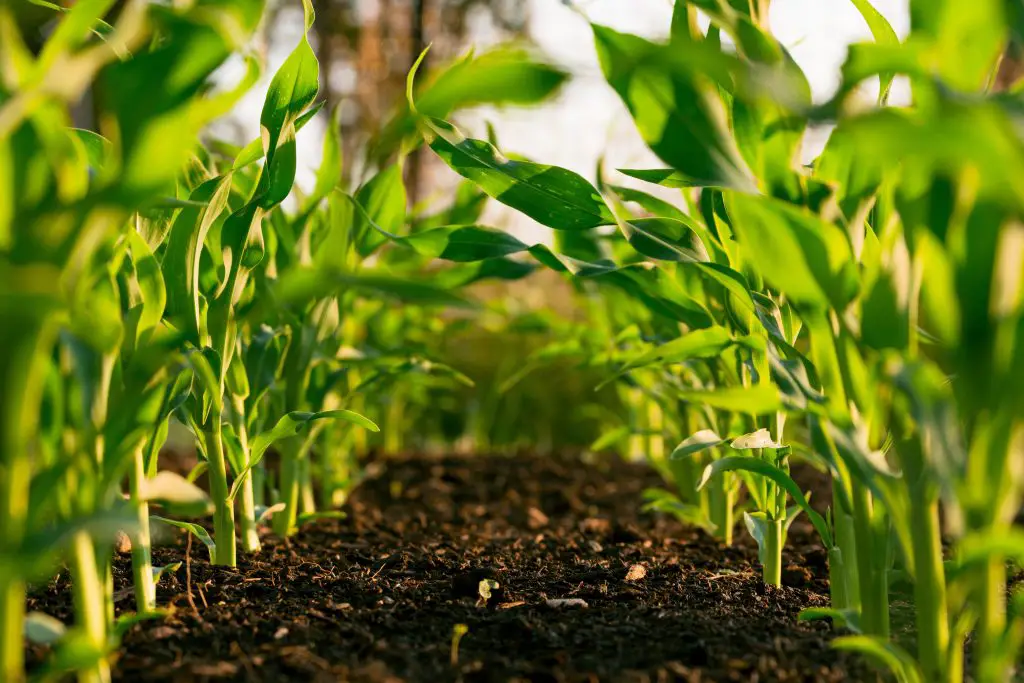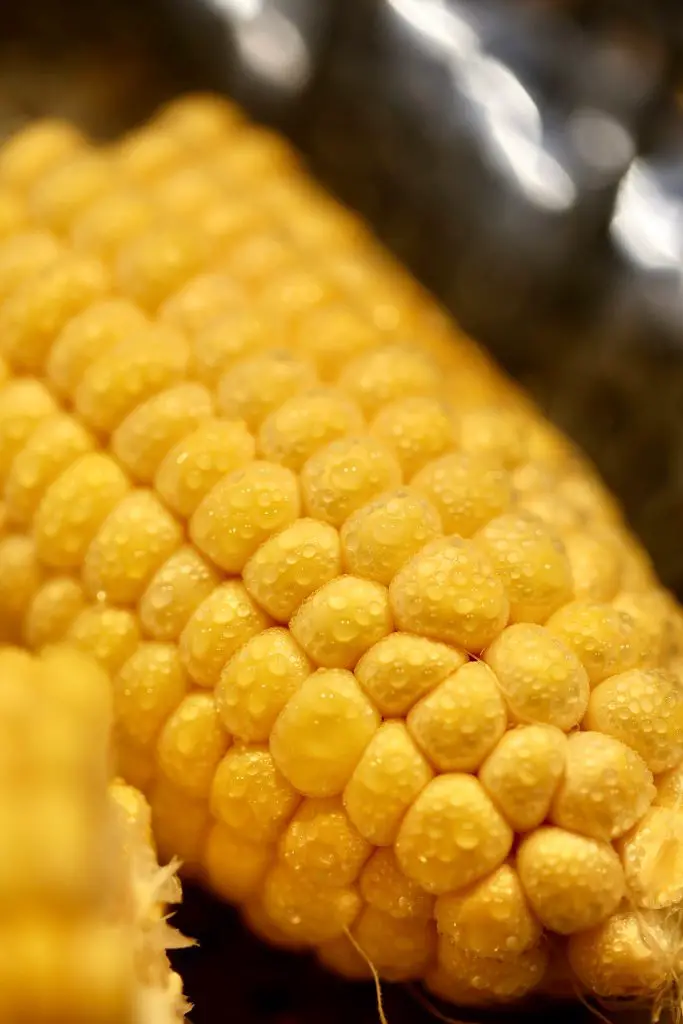How Tall Does Corn Grow? Corn is a fantastic crop to grow at home because you can reduce better quality ears than anything you can buy from the supermarket, however, one of the most common questions that is asked is how tall does corn grow?
Typically, corn will grow approximately 6 ft tall but there are some varieties such as Lancaster Shore Crop or Dublin that can reach as high as 10 to 12 feet tall. However, these varieties are the exception rather than the rule most standard hybrid seeds that you purchase in the local garden centres will produce 6ft tall stalks.
Generally, the vast majority of seeds that are offered through garden centres are hybrid varieties. Hybrid varieties normally contain either the word hybrid in the name or F1 which means the first generation.

Hybrid seeds are produced from a first-generation cross of 2 different varieties. These crosses generally produce the desired traits in the first generation but the seeds cannot be reliably collected for the following year. The reason for this is that they can be collected and grown but the properties of the resultant plants are likely to be quite different to the previous generation of plants.
Conversely, heirloom seeds which are also referred to as open-pollinated are varieties where you can simply put a cob or two of corn aside for the following season. The cob can then be dried out and the kernels on the cob can be snapped off and resign the following year.
To = purchase heirloom or open-pollinated varieties we recommend that you visit seeds now as they specialize in heirloom variety seeds and they are extremely affordable. To visit their site and check out what they have on offer click on the link below.
What Are Some Varieties Of Open Pollinated Corn
While Hybrid Corn seeds dominate the market, there are still many varieties of open-pollinated corn available for purchase, some of which are listed in the table below.
| Variety | Days to Harvest | Description |
| Wapsie Valley | 85 | Produces a plant that is 2m (7 ft) tall, with well-formed ears that are mostly yellow, though some Maroon and Brown ears can appear. |
| Dublin | 86 | Produces tall plants that are 3 m (10 ft) tall, with large Yellow ears. It produces an outstanding yield, that is generally higher than the other open-pollinated varieties. |
| Minnesota 13 | 87 | Produces slender 2.4 m (8 ft) tall plants with Yellow ears. Yields well when in high fertility soils |
| Reid Yellow Dent | 105 | One of the most popular open-pollinated Yellow varieties originated in 1847. Its ears have a deep Yellow, with a lighter cap, but a Reddish tinge often appears. |
| Silver King | 100 | Also, known as Wisconsin No. 7, it originated in Iowa in 1862. It has White creamy kernels, with medium depth and thickness. |
| Bloody Butcher | 110 | Bloody Butcher, an old heirloom variety, dating back to mid 1800’s. It is a beautiful multi-purpose Corn that produces Red kernels. |
| Green Field | 114 | Produces tall plants that are 3 m with Bright, Yellow, cobs. |
| Blue Corn | 115 | An unusual variety that produces attractive dark Blue ears. |
| Lancaster Sure Crop | 115 | Produces towering plants that are 3 to 3.6m (10-12 ft) tall, with narrow ears. Primarily grown as a silo Corn. It is a lot of fun to show off to your neighbours your giant corn. |
| Golden Bantum | 76 | An old heirloom that was introduced in 1902, has fantastic flavour and is great for freezing or eating at home. Produces 1.8 m (6 ft) tall plants. |
How To Grow Corn
Corn is a relatively easy crop to grow, however, as the period in which the cobs are ripe is relatively short the most challenging part is ensuring a continuous supply for as long as possible during the growing season.
To maximize the period over which corn is available to eat in your garden it is advisable to start sowing the 1st crop approximately 4 weeks prior to the last frost. As the plant is frost sensitive the first sowing needs to be done in a seed tray indoors.
Ideally, the temperature needs to be approximately 68°F (20°C) for the plants to germinate at a reasonable rate. Corn will typically take around 7 days to germinate at that temperature. To start the seeds off start by filling a seed tray with good quality seed raising mix and then firming it down into the individual cells to create solid plugs. The solid plugs will make it easier to transplant the corn into the garden later on while minimizing root disturbance.
During the period in which the seedlings are in the seed tray, the soil needs to be kept moist and seedlings should be kept in a relatively warm location. However, if you live in a region that has relatively cold winters it may be worth considering purchasing a heated seed tray as this will control the growing conditions far more accurately than simply placing a tray somewhere inside your house.
If you are considering purchasing a heated seed tray we recommend that you purchased one that has a removable seed tray and a humidity dome. The removable seed tray is advantageous because this is the part of the unit that deteriorates first so being able to replace it with a new seed tray will extend the life of the unit substantially.
The humidity dome is also an important feature for the seed tray because it also helps to maintain a constant environment. To see the latest price on Amazon for a unit with these features click on the link below.
Planting The Seedlings Out Into The Garden
Corn seedlings can be planted out in the garden once the risk of frost has passed, however, ideally the warmer the weather the faster you’ll get a crop. In terms of location, it is important that you place the seedlings in a warm sunny location that gets at least 6 hours of sun per day, and ideally, the location should have rich moist and free draining soil with plenty of nutrients in it.
A seedling should be spaced approximately 10 inches apart in a block rather than in narrow rows. The reason for this is because unlike a lot of other vegetables, corn is wind-pollinated so planting it in a block rather than in narrow rows increases the chance of pollination. It is also important to note that ideally, you should only grow one variety of corn in an area because you can get cross-pollination of varieties which can give you unexpected results.
It is also important to note that corn is one of those crops that can be grown with other types of ground covering vegetables such as watermelon pumpkin and cucumber. This is because the corn will not interfere with the cropping of any of these ground cover plants which will optimize the output of your garden in most cases.
Typically, what I do when planting seedlings out in the garden where I want to put a second vegetable into the same space I simply replace a space where I would plant a corn seedling with the alternative vegetable.

Caring For Corn Plants
Once the corn is in the garden there is very little work required other than to ensure that the plant is watered regularly. However, the one important thing that you need to consider is the successional sowings of corn seeds. Typically, they should ideally be planted around 4 to 6 weeks apart throughout the spring and into midsummer. This spacing of sowing will allow you to produce a continuous harvest for a couple of months.
Harvesting Corn Cobs
Most varieties of corn will produce two ears per stalk these is will produce spindly white fibres from the top of the cob. The first indication that the cobs are approaching the point at which they are ready is when these spindly white fibres turn brown and die back completely.
At this point in time, it is worth peeling back the cover of the corn to check the cobs inside. The simplest test to check whether the corn is ripe is to use your thumbnail to prick one of the kernels. If the cob is ripe it will produce a milky white fluid. If the corn is not yet ready cover it back up and check again in a week or two.
Once the corn is ready it should be harvested immediately as the corn cobs can deteriorate quickly over time so it is one of those crops where you really need to take advantage of the harvest when it is available because it won’t last
I hope you found this article useful and have great success growing your corn at home in your own garden, if you have any additional comments or questions please leave them in the section below.
Relevant Articles
How Long Does It Take For Corn Seeds To Germinate? How Does Temperature Effect It?
When Do You Pick Corn? What happens If You Pick Corn Too Early?
Can You Harvest Corn More Than Once In A Season?
Is Corn Annual Or Perennial? Do I Need To Plant It Every Year?


